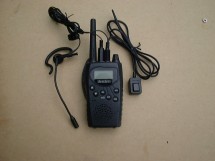
This could be any UHF CB Handheld radio!
(
The heavy reading page!!) "
Improved motorcycle to motorcycle radio intercoms
The picture shows the evolution of the "motorcycle to motorcycle" helmet radio. (model UH-040XR) from THIS.............(12 years ago!!)

This could be any UHF CB Handheld radio!
Operating a microphone/earphone combination in a helmet, on a motorcycle, at speed for either intercom or radio communications is asking a lot . Extraneous noise is the major problem, from wind and engine . Noise produced by the wind rushing around your helmet contributes the greater amount and makes simple filtering of the range of noise frequencies almost impossible. A lot of this band of noise frequencies overlap with speech, so you cant easily remove the noise without affecting the speech and thus loose intelligibility. There are various electronic and digital techniques to improve this signal to noise problem. The use of noise cancelling microphones and circuits with digital signal processing to name a few . These do have a place and will improve the communications quality of a set up. The more expensive intercoms units I'm sure will use some of these techniques (or I hope they would given the cost of some units!) We have studied the problem and after quite a bit of experimentation ( thanks to all those patient and long suffering riders whose help I have enlisted and whose feedback was greatly appreciated during testing) have arrived at quite a simple, inexpensive but cost effective solution. We have found by careful placement of a modified microphone and application of the earphone, you can optimise the speech to noise ratio , get good communications quality audio and not at great expense and complexity.
Here are some of the variables that affect this
systems operation. Some helmets produce more wind noise than others
, also some motorcycles produce a lot of wind turbulence. My '73
850cc Norton interstate is a shocker for wind noise and turbulence, this
is due my bolt upright riding posture and lack of streamlining (Mine
and the bikes). It produces a lot of wind noise as do
most non fairing motorcycles eg old British and American styles ,
However my BMW K100RS with its streamline fairing and wind deflection screen
produces a lot less wind noise around the helmet, as most wind passes over
the top there is much less wind buffeting around the neck region.
hence there is much less background "noise" on my voice
transmissions for the same road speed . I dare say a lot of modern Japanese
and European machines with fairings, will be in the less turbulent
"BMW" category. Wind turbulence is of course related proportionally to
speed in fact it is a cubic relationship, that why it takes so much more power
to go significantly faster! roughly ..to double the speed requires 9 times
more energy!
A snug fitting scarf or neck tube reduces helmet wind noise, If you
can hear the improvement, then your riding buddy at the end of the radio
will too!. You can also move the position of the microphone. Some riders have
found that sliding it through the helmet lining directly in front of the mouth
helps a lot (difficult on some types of helmet). So you can see ,I cant tell you
whether with your set up, you can go at 100 Mph+ (and still have crystal
clear comms) realistically, some how I think not. (I'd be to busy holding
on tight, too scared to talk)
I will, however put my neck out and say that I and another friend Have used them at speeds of 130-140 Kph see testimonials at bottom of page for users comments! and the speech was still OK, not High Fidelity. (due to increase in local wind noise around the helmet as I did not have a scarf on or and earplug in the unused ear. ) but if you understand what contributes to wind noise, interfering with your communications, you can experiment quite a bit to improve the situation .
*** All headset units sold by P.H.S.Ltd before Oct 2002 will not have the modified headset . This modification makes a huge difference to the speech quality at speed, it is a dramatic difference between before and after. You can now converse easily at over 100Kph ! We will modify them for free providing the purchaser provides the paid return self addressed courier bag when sending the units.
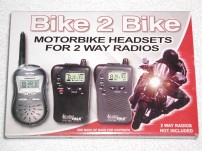
This set-up consists of a 40 channel UHF PRS radio and a
specially adapted earphone-microphone unit. This can be worn with comfort and be
effective underneath a full face motorcycle helmet. The waterproof push-to- talk button is thumb
operated from its position attached/clipped, to the left-hand handlebar .
It has been found that although VOX (voice) operation of the radio system
would be an attractive advantage, the wide spread in motorcycle engine and helmet
wind-noise, coupled with the added expense and minor technical nature of setting up an
effective personalised VOX system, precluded it as a worthwhile feature. . ( we do
sell vox systems that will work , but the model of radio that has this
function tends to be much more expensive, and Vox can be made to work well
only with a full faced motorcycle helmet) Some brands of radios can only be
operated in VOX with an external headset like the uniden 041, some brands
of radio have a poor VOX with slow attack so be careful about your purchase
don't be afraid to ask us, we can tell you which Australasian radios aren't all
that crash hot in the VOX dept! in fact our own import favourite the
WT419 water resistant radio has a crap VOX !! .
We have found that the simple thumb push-to-talk
PTT system is the easiest to understand and the most reliable to operate
in just about all conditions.
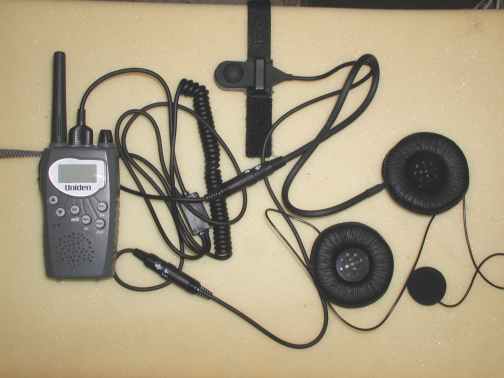
To THIS......The new flat headset Design with optional (free) acoustic isolating ear-cushions
Key Benefits: A lot of these features apply to many different brands of radio not just the Uniden!
| The whole communication set-up can be used without any modifications to machine, Rider or helmet. | |
| Easy installation and set-up within minutes. | |
| The Radio has excellent sensitivity and adequate RF power output (500mW) to give good usable range between riders up to 3 Kms+!. It also has Ministry of Commerce certificate of compliance . | |
| It is Narrow Band FM so has excellent rejection of impulse noise from ignition systems. | |
| The headset and push button can be unplugged and the radio carried in the shirt pocket. It can be used as a short range communicator at meetings and race venues (cheaper calls than a cell phone ) and can communicate with more than one radio at a time (can't do that on a cell phone). | |
| The radio is very small (packet of 20 cigarettes size) and not obtrusively heavy or bulky. | |
| Clear backlit LCD screen. | |
| Uses an Auto Power Save function for longer battery life during stand-by periods. | |
| A Keypad Lock facility helps prevent accidental changing of the radio's settings. | |
| A Battery Level indicator on the LCD screen shows when the batteries are becoming exhausted. | |
| Many riders can be on a common channel if travelling in a group. | |
| Earphone microphone is very small and light and can be tolerated in the average ear for long periods of time, | |
| The microphone is held firmly near the mouth so the voice is heard clear and distinct. | |
| The Earphone has more than enough volume to drown out the sound of wind and engine noise . | |
| The system has had extensive trials with motorcyclists with little electronic skills and found ready acceptance. |
Use of the System:
The headset and PTT cables are plugged into the appropriate jacks on the top of the radio.
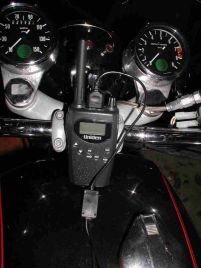
Thick one is the speaker, thin one the microphone. The radio is turned on and the volume adjusted to a predetermined level of comfort. Make sure "DUP" is not displayed. Set the radio channel via the up-down buttons to be the same on all radios. Please do not use ch 11 for routine communications, as this is the emergency calling channel. The PTT thumb-switch is attached/clipped to the clutch side handle bar now by a Velcro strap and placed in a position where it can be easily operated by the gloved Finger or thumb in a comfortable riding position. The water resistant PTT switch has a positive feel to it and has a quick disconnect mini din plug and socket so the radio and cable assembly can be removed from the bike with the PTT switch left affixed to the handlebar.
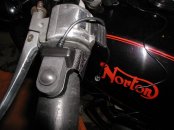
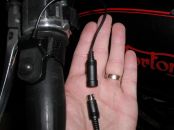
PTT button on handle bar Minidin disconnect plug and socket
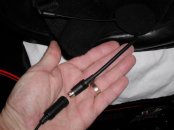
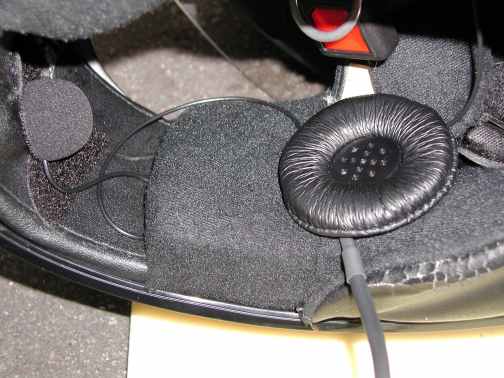
Headset in helmet with disconnect Mini din plug and socket Flat headset in position
We have developed a one piece "flat speaker, both ears" and associated boom microphone system for improved user comfort and ease of installation (It is held inside the helmet by Velcro hooks ). The prototype "flat headset " has performed acoustically very well, and is extremely comfortable, the wearer hardly knowing it is in position. It is also much easier to take the helmet off and on without undue discomfort Take the foam cover off the boom microphone and make sure that the speech holes are directly facing your mouth ,if they are not twist the boom mic so they are directly in front of your mouth, The correct microphone side is matt black down in the 'holes if you can see shiny bits down in the speech holes then that is the back of the capsule, the wrong side !
Tight Helmet??
We have a thinner headset (8mm thick when compressed!) microphone assembly for those of you who have a very snug fitting helmet and the standard boom mic ear-speaker assembly could be too tight for long term comfort . The only real difference is the microphone is not on a boom and connected to the speaker, The removable ear speaker is held into the helmet by Velcro, the Velcro sided microphone is "stuck" with sticky double sided foam adhesive strip to the chin bar directly in front of the mouth. The microphone can be peeled off the chin bar but leaves the Velcro "wool" stuck to the inside of the helmet. This makes it somewhat difficult to swap the whole headset to another helmet as you leave the microphone Velcro "wool" behind! This may not be too much of a problem if you only have one helmet and are going to leave the headset in place at all times .
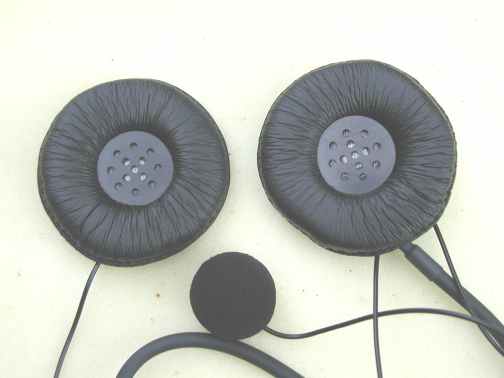
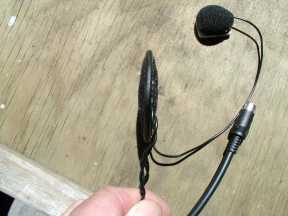
with ear cushions fabric cover no ear cushions
The helmet is pulled wide via the chin-straps "out and over" the ear and being careful not to dislodge the earphone. You will find a tendency for the top of the ear to be folded over by the passage of the descending crash helmet, feed the helmet over with the ear held carefully to prevent this, When the helmet is on, minor adjustment in the position of the headset can be done with the un-gloved hand. To get the best "at speed" performance , make sure the earspeakers are correctly positioned over the ears ,move them around over the ears until they are in the "loudest" position . Spend time to arrange it into a comfortable position .
You will notice that the headset unit now has a quick disconnect minidin plug and socket assembly ,so that you can unplug the helmet from the radio harness and dismount easily ie when you have to get off your motorcycle to fill it with fuel , rob the gas station etc etc. Then hop back on and then plug it back together . The minidin plugs used for PTT switch and helmet are quite water resistant and a thin wipe of silicone grease onto the mating surfaces will go a long way to improving this. There is a simple modification to this set up that will enable you to run the Uniden '042 on VOX mode ask me about this if you are interested but please note that the Uniden' 042 is a more expensive radio ...but with a lot more features as well!
OPEN HELMET MICROPHONE:
BOOM MIC :
We are also have a boom microphone for use with an open face helmet , this
is a little bit of a tall order with the microphone being out in the wind,
unlike a wire mic "sheltered" inside a full face helmet. I would
prefer the boom mic to come off the earphone and not be attached to the
outside of the helmet . This makes for a much sturdier microphone and also
means that the mic can be protected from the wind when you have your visor
down.
Where to place the radio?
The radio can be placed in a pocket of the riders leather jacket. The radio is NOT water-proof ! so cannot be kept out in the wet weather unless placed in some sort of waterproof container. I use an upside down ziplock bag pulled over the top. ( However look at this radio the WT 419 , it IS shower-proof!!) See Mounting hints There is a trap for novices with this radio and most others , It has the ability to be used with a radio repeater to boost its communication range. For Bike to Bike communication you need to operate in "simplex" mode. If you press one of the buttons marked "DUP" on the front panel the radio will go into a "split" on transmit, i.e. the transmit frequency will be slightly different from the received frequency and you cannot talk from radio to radio UNLESS you are going through a repeating station. (There are some UHF CB repeaters around new Zealand.. somewhere?? where ??? !, But there are a lot more CB UHF Repeaters in Australia! see below ) Make sure "DUP" is disabled (i.e not showing on the display).
Note for Australian users:
I suggest you do not to use the first 8 channels in simplex mode , unless
you intend to access a repeater (in which case you do
want to use duplex mode, it is handy to leave
this enabled on these channels). Ch
11 in Australia is no longer the emergency calling channel, it is now a
backup and the real emergency channel is Ch5
and its associated repeater uplink Ch 35. (channels
31 to 38 are best not to be used unless your accessing a repeater through
duplex mode). 22 and 23 are now reserved in Australia for data and telemetry,
just to add to the confusion :)
What range will I expect to get?
Radio range is very dependant on where you place the radio. The more you shield the radio up against your body ,the more your internal blubber will soak up the signals and there will be less to radiate out into the air and towards the other riders. Having it on your person will also cause a shielding effect of your body in certain directions, that will limit range. The optimum place to have the radio is attached to the side of your helmet up out in the clear, this gives the best range. I have found that attached to the fairing of your bike ,if it has one, with the antenna vertical if possible, is a good spot, or clipped to the brake, clutch or other cables at the front of your machine, gives good range as well. Make sure the radio is adequately attached to the bike by the supplied wrist cable. If it meets the road at 100 Kph +, its life chances are very slim and that particular fault is not covered under the radios' warranty! Check out this picture! to see what a following car transporter can do to the untethered Uniden radio!
Radio range will also depend on the terrain you are riding through. Built up suburban or city centre can be down to one or two blocks, steep rolling country my be only up to a kilometre, but out on the open plains with the radios in the optimum place on both communicating 'bikes", you may get up to three Kms+. I have had up to 5 Kms riding out in the open country on the Desert Rd in central North Island of New Zealand, although I would call that range an exception more than the rule. if you do want more range then look at this option extending the operating range
Battery life: Like everything, it depends how hard
you flog it along . The Alkaline batteries in my demonstration units appear to last for weeks!
At a local sawmill here, where they use these radios for comms, they regularly get
7-9 days out of a set of alkaline batteries. These guys have them running all day too.
Remember it is transmitting that uses most of the battery, receiving doesn't
use
much at all. I suspect with intermittent use which allows the batteries to bounce
back somewhat, you could easily get several weeks out of them . You
can buy re-chargable AAA and AA cells in Nickel Metal Hydride Format , some
of the AA cells are 2000 mA/Hr!!! they would last ages in the radios ,some
rechargers for these batteries take only 1 Hr too !
(Our new 2 Watt WT419 comes complete with
4 AA re-chargable NiMHi batteries, charging base and AC adapter !
( no longer sold )
Being able to communicate while riding brings on a whole new aspect to motorcycling. Friendly chatter helps pass the time of day. You can warn each other of impending misfortunes (police ahead etc) road surface warnings relay to others danger on the road , and give directions to other riders where to turn why you are stopping , call for help if lost! , "hey joe, your back tyre looks flat" "slow down boys, radar patrol car ahead of me! etc and the list goes on .
Motorcycle two-way radio is not for everybody . Some love the peace and tranquillity
and
the solitude provided by this recreation and don't wish to converse with
their fellow riders , then this addition to the pastime is not for you .
What I have also found is that the ones that scoff at the concept of talking
from bike to bike are the ones that dont want to give the gear back after they
have tried it out !!
"WARNING! WARNING! Will Robinson..... " (visions of flailing robot arms)
** The prs radio described here is only licensed to use in New Zealand and Australia. Their frequencies are different to those PRS/Family radios used in Europe and USA . Don't be tempted to use PRS radios imported from Europe or USA here in Australasia , or vice versa. These USA and European frequencies here are used by commercial fleet operators etc. You will cause all sorts of interference and no doubt will be interfered with by much more powerful long range commercial trunking radios, these will become a real nuisance to you. You will also have the relevant Radio regulatory Authorities (Radio Frequency Service here in NZ ) track you down with direction finding equipment and they will come down on you like a ton of bricks due to the interference you will cause to commercial $$$ operators $$$$ (they.. RFS, may want to recoup their expenses)
specifications: UH-040XR/ UH-042XR ( SOLD OUT SORRY)
40 channels( now 80 ch's) from 476.425MHz (ch 01) at 25 kHz (12.5Khz) spacing up to 477.400 MHz (ch 40) duplex channel support with 750kHz split , use 3 "AA" cells , case size 160*62*32, weight 150gms no batts, Alkaline battery time is 38 hrs at 5 sec tx,5 sec rx and 90 sec standby, (continuous use) Tx rf power output 0.5 w,320 mA drain, Receiver dual conversion PLL, sensitivity 0.22 uV, squelch at .19uV, 150mA drain at 50mW audio output, all in all a very fine performing handheld transceiver . UH-042XR has the same specs as above but has user presetable "vox" capability and the standard 38 frequencies of subtone (CTCSS coded squelch) it is a more expensive radio,
There is now a cheaper Uniden UHX-037 radio available with similar RF performance to the "040/042 series . It is a shame that this little radio doesn't have external earphone and speaker sockets , unfortunately uses 3 "AAA" alkaline batteries. (which do not last anywhere near as long as 3"AA" alkaline batteries ). I will be looking at how to implement this less expensive radio for motorcycle comms, it may mean hard wiring the ptt and headset into the radio that will invalidate the Uniden warranty. check out the inexpensive Custom PRS1600 system (discontinued )
** I have also discovered a manufacturer that does a similar type of radio that incorporates an FM radio receiver covering 88- 108 MHz ! so you can listen to your favourite radio station whilst you ride. This extra feature is selectable. The FM radio is disabled when you receive a radio transmission from your buddy but comes back on to FM when the transceiver mutes. The only thing about it I don't like is that it uses 4 AAA cells . These tend to have a lesser capacity than AA cells, are more expensive hence don't last nearly as long and with the radio receiving FM continuously, that will make their operational life even shorter one could of course use rechargeable NiCad AAA cells..... BUT watch this space for more details!!!! I'm still waiting for them to produce the unit with 40 Australasian channels! ( Turns out this radio cannot be used with an external PTT control and must be used on Vox mode with our headsets , I was not overly impressed by the very slow action of the VOX on this radio so I opted not to import it! )
IMPORTANT ***However, many of you may
already have the Uniden "040/042/044/041 radios, or other types .
If you are in Australia,
it will be better (cheaper) for you to purchase your own UHF radios from
elsewhere eg "Dick Smith " ?Jaycar etc...chain stores as they are
probably cheaper than I can sell you them at!
JUST HEADSETS ONLY ??:
DONT forget to look at the "SPECIALS" PAGE !!
the "K" series which includes the walkman/CD player interface cable so you can
listen to your own radio/CD/Walkman while you
ride at $NZ
80 .00 each
""
And don't forget we have CELL Phone headsets Only so you can receive calls while riding these fit cell phones with a 2.5mm earphone socket at $NZ 45.00 each These don't interface with the uniden radio cables yet ! they are a separate item.
Not to be confused with the cellphone interface unit that DOES
interface with the "K" Series radio headsets have a look at our bluetooth
cellphone headsets
for motorcycle use !!
These headsets will work on other brands of radios but may require the correct plug type to do so . Please let us know the brand of radio first so we can ensure you have the correct plug before sending the headsets. The Headset unit at the moment has a moulded dual speaker mic plug, ( microphone is a 2.5mm plug and Speaker is 3.5mm) the pin spacing centre to centre, is 10mm , Some brand of radio have different plug spacing and configuration. a single 2.5mm plug we have those on our headsets too, That is why we need to know the radio you propose to use. if you think your radio is different, contact us first before ordering as we may be able to help .
Want to go back to Motorcycle communications? ...... click here!
Contact:
Pinfold Health Services Ltd., 1172 Arawa St. ,Rotorua , New Zealand ph +64-7-3488850 fax +64-7-3486555 pinfold@xtra.co.nz